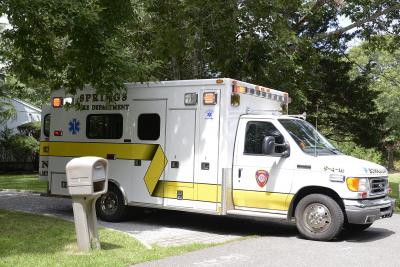Springs Resists Calls for Paid E.M.T. System
Springs Resists Calls for Paid E.M.T. System

Officials from East Hampton Village and the Amagansett Fire District had a sit-down two weeks ago with the chairman of the Springs Board of Fire Commissioners to express their concerns about how often other agencies have to respond to emergency calls in Springs.
The Springs Fire Department is the only agency on the South Fork without a paid provider on duty at least during the day — and there are no plans to add one, despite the difficulty the district faces in getting a volunteer crew to answer calls, especially during the workweek.
From July 1, 2014, to July 1 of this year, Springs needed help about 26 percent of the time from outside the district to answer 441 calls for service, including 89 calls to assist other districts.
Compared to the four other ambulance districts dispatched by East Hampton Village, Springs fared the worst. Sag Harbor needed the least help, about 3 percent of calls, Montauk less than 4 percent, East Hampton about 5 percent, and Amagansett less than 8 percent.
Springs had the fewest calls.
East Hampton, meanwhile, received 1,427 total calls, 1,186 in its own district. Its ambulances answered 65 calls in Springs. Amagansett, which had the second fewest calls, received 486 over that 12-month period, including 312 in its own district.
Rebecca Molinaro, the East Hampton Village administrator, called the meeting with Patrick Glennon, the Springs chairman, after it became apparent that the East Hampton Village Ambulance Association was answering a larger number of calls in Springs. “It’s taxing on our volunteers,” she said in an interview last week.
“We’re constantly going there, and so is Amagansett,” said Barbara Borsack, the village deputy mayor and a longtime emergency medical technician in East Hampton. “I would say my main concern is the burnout of our members. At the same time, we can’t let people go without help.”
Officials in neighboring districts would like to see Springs move in the same direction the other agencies have so that patient care starts earlier and ambulances get on the road faster.
Two and a half years ago, all of the agencies serving the areas east of Water Mill were volunteer-only. Despite early resistance, an increased call volume led to a change in philosophy and most de partments began to believe that a paid provider with an advanced level of certification, like a paramedic who responds to a call immediately in a first-responder vehicle, could supplement existing emergency medical services on the South Fork. The Montauk Fire District was the first in the Town of East Hampton to start a paid program in 2013, first having a paid responder on duty 12 hours during the day, and later moving to around-the-clock coverage. The Amagansett Fire District and the East Hampton Village Board followed suit in time for summer 2014, and this summer the Bridgehampton Fire District and the Sag Harbor Volunteer Ambulance Corps got programs up and running.
Earlier this month, the East Hampton Village Ambulance Association’s program moved to 24-hour coverage. The village board, which oversees the association, more than doubled the initial funding for the program to $225,000, just for salaries. “It’s a financial and moral commitment that the village is going to continue,” Ms. Molinaro said.
“Springs is not ready to do any type of paid system,” Mr. Glennon said. “Maybe in a couple of years if we find that is the problem. As of right now, we don’t feel that it’s a major problem.” He denied that there was a major issue with the service the district provides and disputed the figures. In addition to being on the board since 2005, Mr. Glennon has been an ambulance volunteer since 1991 and a critical care technician since 2000.
The district cannot afford a paid service, he said. As it is beginning to look at the budget for 2016, he said the district can only add $6,800 to its current budget of just over $1 million in order to keep increases under the 2-percent tax cap. He acknowledged that the board could pierce the cap if its majority approved it, but he said, “We’re not looking to do that.”
Mr. Glennon believes Springs taxpayers, who are paying the highest taxes in East Hampton Town, mainly due to school taxes and a small business district, do not want any increases. “I know I’m a taxpayer in Springs and I don’t want my taxes going up.”
David King, who serves as the Springs Fire Department chief, said the volunteers, often working two jobs to survive here, are doing the best they can. He believes the district has to find the money for a paid provider to help take the burden off the volunteers. “In my opinion, we need one, but financially, it’s a hard sell,” he said, adding, “It’s just the cost of doing business. It’s the cost of having a municipality.” The chief said he has spoken to the commissioners at their district meetings at least three times since the first of the year on this topic.
“Whatever they need to do to man it, I’m for it. We’ll do without on the fire side of it to get enough money in the budget, or as much as we can, to fund a first responder,” he said. He feels so strongly that he would give up the vehicle provided to him by the district if it would help.
“Maybe it doesn’t have to be 24 hours, seven days a week. Maybe they can do a 12-hour shift,” Chief King said. A program like that has cost other districts just over $100,000 a year with per diem employees. “Let the residents of Springs decide what to do,” he said.
Mr. Glennon believes his neighbors are “taking the easy way out” by spending hundreds of thousands of dollars annually on the program. “Before we do that we’ll throw money at training,” he said. For the past two years, Mr. Glennon has said that he wants to see money put toward a regional training program to teach advanced level classes on the South Fork (basic life support classes are taught in Sag Harbor annually). “I’m not saying in one year you’re going to solve all the problems of the East End E.M.S. system, but if you do it for several years. . . .”
“For the short term, we’ve just got to talk to our volunteers and tell them to start stepping up a bit — summer is the problem,” he said.
A shortage of volunteers during the day is not unique to Springs, and officials said it is only made worse when the volunteers who can respond are being called so much to answer other agencies’ calls.
Here’s how the system works: When a caller dials 911 from almost anywhere in East Hampton Town, a dispatcher located at the East Hampton Village Emergency Service Building answers. If it is an ambulance or fire-related emergency, the operator will dispatch the appropriate service from the district the caller is located in.
There are two types of ambulance calls: basic life support, like a sprained ankle or general malaise, and advanced life support, required when a patient is having a heart attack or serious allergic reaction, for instance. If a crew has not signed on within two minutes for an advanced life support call or within three minutes for a basic life support call, the call goes out over the paging system again. After the second reactivation — six minutes into an advanced call or nine minutes into an basic call — a neighboring district is called for help. If that neighboring district cannot help form a crew, it is dispatched to the next district, and so on, until a crew is confirmed.
For example, on Aug. 10, a Montauk ambulance responded to a call on Gardiner Avenue in Springs, arriving 42 minutes after the initial call was dispatched at 8:33 a.m. A Springs emergency medical technician eventually got to the patient 15 minutes before the ambulance arrived.
While a patient waits for an ambulance, so does a police officer. Police officers are often the first to arrive and administer basic care, such as oxygen. “Obviously, it is not ideal for our officers to be left with primary care for any prolonged period of time, both from a police operations standpoint and from care and safety concern,” said East Hampton Town Police Chief Michael Sarlo. “Getting the fully equipped and trained personnel to the aided as quickly as possible is the primary goal, and the districts that have gone to the paid service have managed to increase their operational efficiency in those areas,” he said.
From July 1, 2014, to July 1 of this year, East Hampton was called to Springs 118 times, though it only transported 57 patients because Springs either eventually formed crews or another agency answered the call. Meanwhile, Amagansett was called there 57 times and only had to transport 5 times.
Longstanding agreements for what the agencies call “mutual aid” are necessary, all agree, because if there is an accident involving several vehicles, additional ambulances will be needed. Multiple calls at once also require the help of neighbors. Most agencies have just two ambulances, though East Hampton and Montauk have three.
A paid system does not solve all the problems in an E.M.S. system, but it has made a huge difference, Ms. Borsack said. “What it’s done in East Hampton, is it’s enabled you to just handle the call with just a volunteer driver,” she said. Plus, it has cut back on the need for help from other districts. “Mostly now, if we’re mutual aiding it’s because we have all three ambulances out.”
Paid providers have been used a bit differently under the mutual aid agreement. Whereas a volunteer, whether a paramedic or basic emergency medical technician, may respond to any mutual aid request, paid providers have been held back from going to help neighbors. Most districts have agreed they will only send the on-duty personnel when a patient is in cardiac arrest. The idea, Ms. Molinaro said, is that the district paying for that service wants to ensure that provider is available to its taxpayers should an emergency arise.
“It’s that mutuality that we’re looking for,” said Jack Emptage, the chairman of the Amagansett Board of Fire Commissioners, who sat in on the Aug. 5 meeting with Mr. Glennon. “Springs residents have got to realize that they are really losing out. I don’t think, I haven’t read anything anywhere, and I know within Amagansett, there has been no backlash to it.”
However, Springs fire commissioners say the residents cannot afford a program even if the cost is $50 extra on an annual tax bill. “Maybe in Amagansett that doesn’t matter, but here in Springs, raising taxes $50 a house just to have 24/7 A.L.S.?” Mr. Glennon said shaking his head.
Chris Harmon, who is on the Springs Board of Fire Commissioners with Mr. Glennon and three others, said Tuesday that while he is also concerned about the budget, a paid program is something “we should take a look into” as a group. Mr. Harmon drives the ambulance and said he knows all too well how hard it is to get a full crew together, but he also said he has responded to plenty of calls to help neighboring districts over the years.
Leander Arnold, who was elected to the board in December and volunteers as a driver, said he is also concerned about the situation. “We’re a very low tax base,” he said. “Is it going to be really worth it to have someone sitting around the firehouse all the time or is it going to be cost effective?” he asked.









